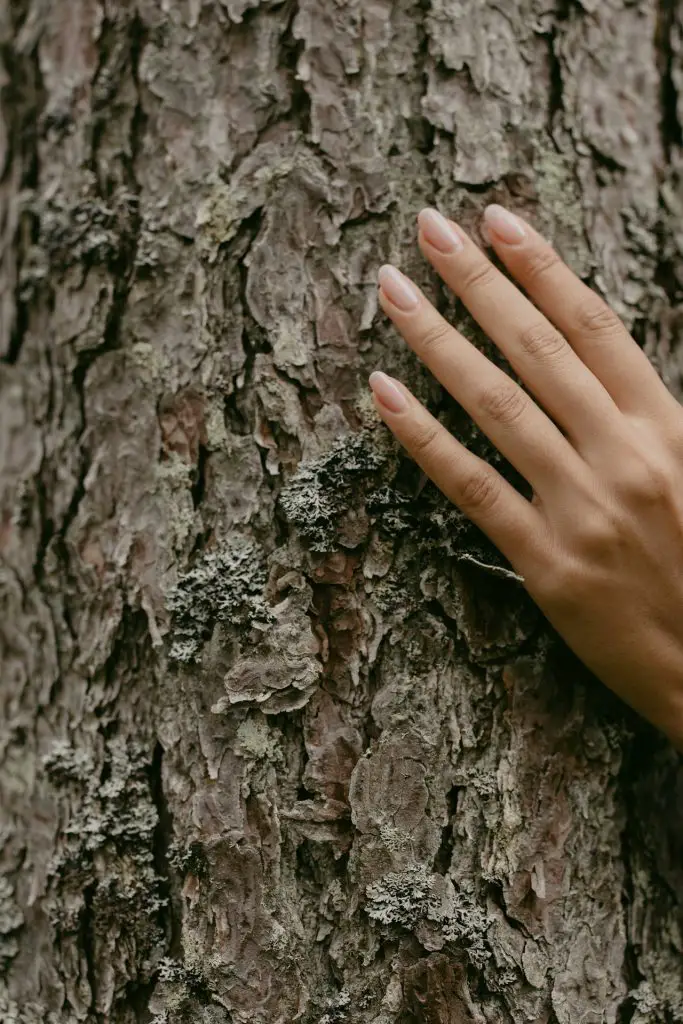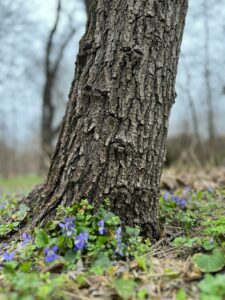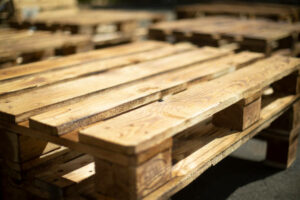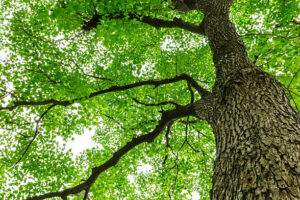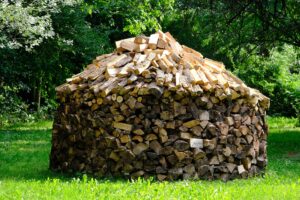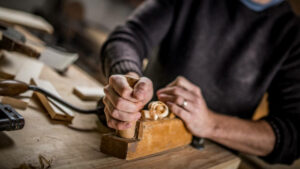Coppicing is an ancient woodland management practice that has been used to rejuvenate stands of trees. It involves the periodic cutting back or removal of tree stems either close to ground level, at about 30-40cm height, or on a stool (a short raised stem), with the intention that new growth will appear from buds within the stump or stool, which will shoot out again to form the next generation of trees.
Coppicing is practiced commercially on hazel, sweet chestnut, and oak (see below), but any deciduous, woody-stemmed tree can be coppiced including sycamore, birch, and maple. Trees tend to be coppiced when they are mature or past their prime, but before they reach full maturity. They are coppiced without felling the entire tree.
Coppicing mainly occurs in wood pastures and ancient woodland where traditional management can help to maintain a wide range of tree species by periodic cutting back which prevents the trees from getting too big. These habitats play host to many specialist plants and animals which are only found in these environments.
History of Coppicing
Coppicing has been used in woodland management for centuries. The Domesday Book (1086) records that over 1.4 million acres of wood pasture in England contained coppiced woodland.
Since the Second World War, when there were around 100,000 hectares of copses in England and Wales, there has been a huge decline to an estimated 25-30,000 hectares today (The National Archives, 2012).
Plants Suitable for Coppicing
Some trees are more suitable for coppicing than others. They must have the following attributes:
- A strong, straight stem that will produce long, thin poles or small diameter wood.
- Produce new growth from the base of the plant (a lignotuber) where buds can be activated by cutting.
- Vigorous and freely-growing coppice stems.
Examples:
Acer campestre (field maple) – It is an upright, shrubby tree that will grow into a standard tree unless coppiced. While young it can be cut back every few years to around 2m above ground level and new stems will develop from the base. These will grow to around 6-8m when they are coppiced again.
Acer pseudoplatanus (Sycamore) – It is an upright deciduous tree that can be cut back at about 25cm above ground level. The regrowth that follows produces long, thin poles which are suitable for basketry and other crafts.
Aesculus hippocastanum (Horse Chestnut) – It is a large, deciduous tree that can be cut down to ground level annually during its first year. However, the coppice growth is relatively weak and stems are best reserved for wildlife or other less demanding uses.
Betula (Birch) – Birch is more difficult to coppice effectively than some other trees as it has evolved to regenerate by suckering. It is best coppiced under-story trees to provide poles or firewood.
Carpinus betulus (Hornbeam) – It can be cut back at about 25cm above ground level and new shoots will grow from the base of the plant. The stems are slow-growing and have a faint, attractive zigzag pattern.
Corylus avellana (Hazel) – It is perhaps the most efficient of all the coppice species. As soon as you have cut it back, anywhere up to 90cm above ground level, growth will start from the base of the plant and produce long flexible stems. Hazel growth is fast so shoots need to be harvested every 3-4 years, and the growth on a stool will be heavier than growth on a coppiced stem.
Crataegus monogyna (Hawthorn) – Hawthorn is best suited to wildlife uses such as coppicing because of its suckering habit which reduces the vigor of new shoots. Branches can be cut back to about 25cm above ground level and will often regrow from the base of the plant.
Gleditsia triacanthos (Honey locust) – It has a large lignotuber that aids its efficient coppicing, producing vigorous basal growth with little suckering. A quick-growing tree that can be cut at about 25cm above ground level.
Pyrus communis (Pear) – It has a lignotuber which makes it easy to coppice. The stems produce suckers which can be beneficial in pollarding applications. It is important to note that the tree will create thorny suckers so it may only be suitable for low hedges or wildlife uses.
Quercus robur (Oak) – It is difficult to coppice because of its long periods of dormancy and slow growth. However, it will naturally grow into standard trees if left un-pruned so can be coppiced at about 15cm above ground level. Coppiced oaks will produce standard trees with an open center. It is not advisable to use coppiced oak for fuel because of its slow growth and high moisture content.
Robinia pseudoacacia (Black locust) – As with Gleditsia, Black Locust has a lignotuber which aids efficient coppicing. Can be cut at about 25cm above ground level and will produce new growth from the base. Coppiced black locusts can be used for carving or furniture making.
Salix spp (Willow) – Most species of willows are easily coppiced and can be cut back at about 25cm above ground level to around 30% of their height. They will grow back from the base. They are particularly good for use as stakes, posts, or fencing because of their long, flexible stems. If you cut a willow stool down to ground level it should be done in the autumn to allow time for new growth before winter sets in. Willows can produce many shoots over a period of several years which can thicken the stem if not pruned.
What Does Coppicing Do?
Coppicing is a form of woodland management that stimulates the regrowth of trees. It encourages biodiversity and improves habitats such as wood-pastures where rare plants and animals can thrive (Natural England, 2013; The National Archives, 2012). Coppiced trees also provide valuable materials such as poles, firewood, and charcoal.
Tools Used for Coppicing
Felco pruners, secateurs, and loppers are the most popular tools for coppicing. This is because they are light to handle, easy to use, and give clean, accurate cuts.
How is Coppicing Carried Out?
Coppicing methods vary depending on tree species and the size of the tree. Coppicing smaller trees are usually done by cutting the crown back to a stool, while larger trees are felled. The cut stems are called standards which will grow through the coppice cycle into new trees. Any number of standards can be left if they are required for a specific purpose such as fencing or stakes.
The main aim of the coppice cycle is to manage the growth and development of each standard so that it has a chance to become a well-formed tree before being cut back again. It takes about 12 years for a standard to fully recover and produce more vigorous regrowth.
Coppicing is done in stages, taking about two months per cycle. A coppiced woodland can be cut every 5-10 years depending on the species of tree and how prolific it is in growing back shoots from the base. A new stool should be allowed to develop for 12 years before the next rotation.
Coppicing trees does not kill them but it can sometimes weaken them directly beneath the cut, particularly on larger trees where there is less of a root system. The tree must be able to draw water and nutrients from below ground as well as above ground, so cutting back too much will harm the tree’s physical structure.
The most ideal time for coppicing is in the spring after any frost damage has passed and before new shoots appear, although it can be done at other times of the year if necessary. The best time to cut back a standard is just before it begins to grow so that there is enough energy still inside the tree to produce new shoots.
Coppiced trees can live for many years and the coppice cycle continues until the tree is cut back to ground level. The aim of coppicing is to achieve a well-formed standard which will produce lots of strong, straight stems when it regrows.
Why is Coppicing Being Stopped?
In most woodlands in England, coppice has been gradually abandoned as a management technique over the past 60 years. This is mainly due to a change of farming practices which have reduced the need for natural woodland management techniques such as coppicing. Farmers need fewer wood supplies for livestock and fodder because of increased mechanization which means that less land is needed for farming.
Single-stemmed trees are now preferred to coppiced woodland as they provide better quality timber. Coppicing has also become unfashionable since the 1950s when uneconomic ancient woodland was often cleared to make way for new, even-aged plantations.
